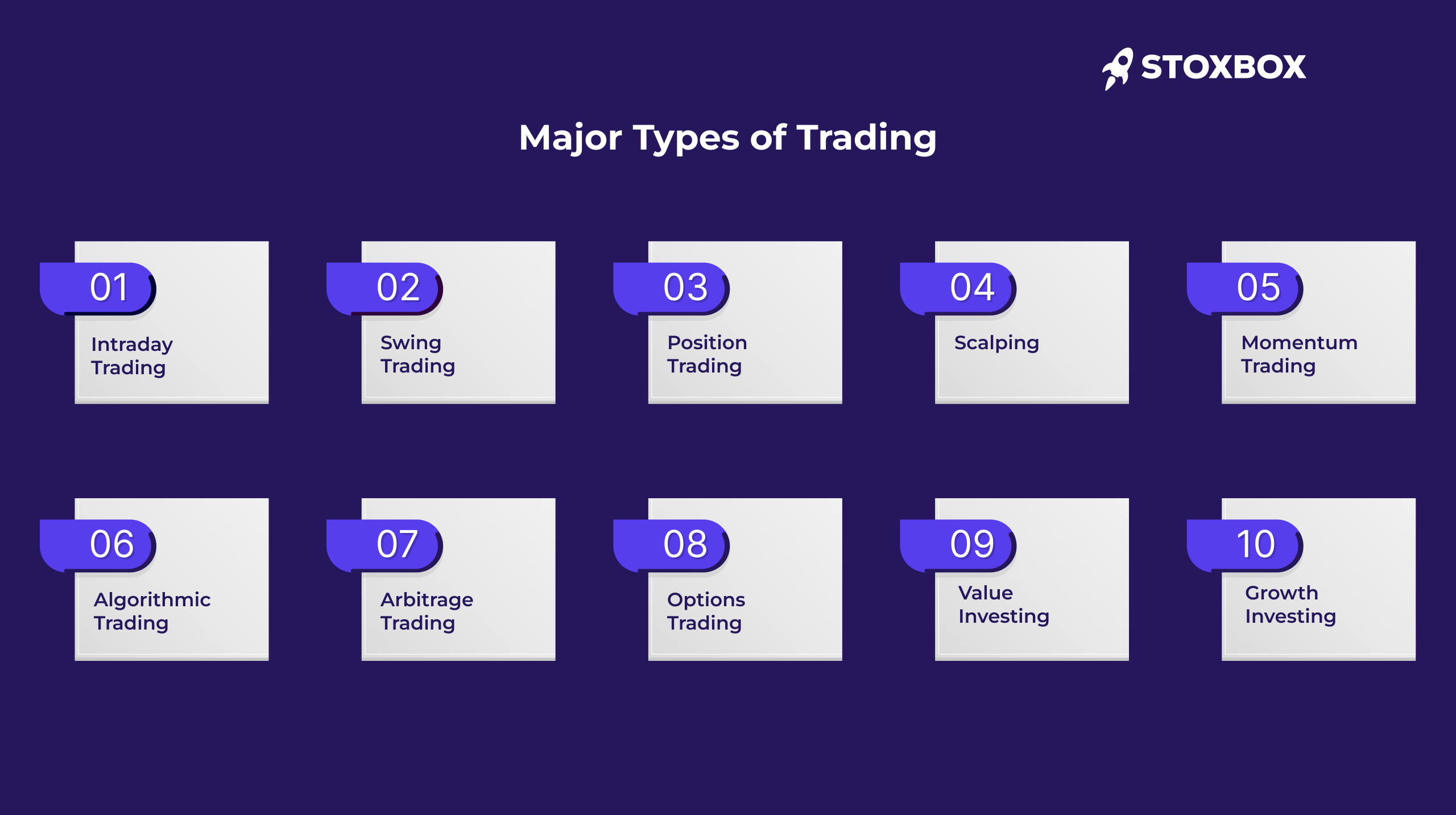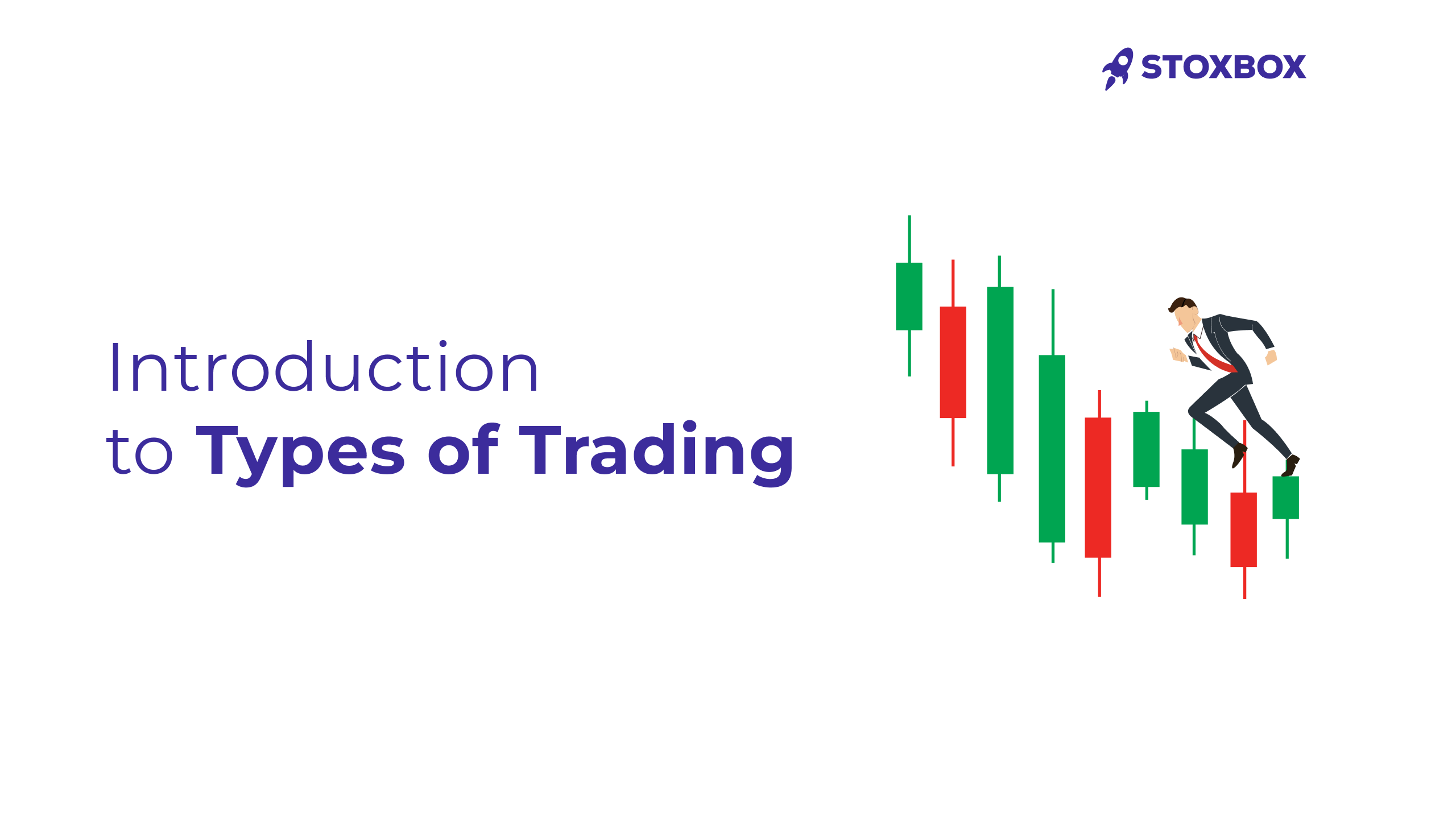Looking for right trading option . Choose your trading type and start trading
Table of Contents
Trading in the stock market offers a wide array of opportunities for individuals looking to grow their wealth or make quick profits. However, the stock market is a complex ecosystem, and one size doesn’t fit all when it comes to trading strategies. Understanding the different types of trading is essential to navigate the financial markets effectively. Each type of trading comes with its own set of risks, time commitment, and skills required. By knowing these types, traders can align their strategies with their goals, risk tolerance, and market knowledge.
Common trading styles include day trading, swing trading, and intraday trading, among others. Each of these approaches has unique characteristics that appeal to different types of traders. Whether you are a beginner or an experienced investor, understanding these types of trading is crucial for long-term success in the financial markets.
What is Trading?
Trading is the act of buying and selling financial assets, such as stocks, commodities, currencies, or derivatives, with the goal of making a profit. Unlike investing, which typically involves holding assets for a long period, trading focuses on short-term market movements to generate returns. Traders aim to capitalize on price fluctuations in the market, often within very short time frames.
Trading occurs in various markets, including the stock market, foreign exchange (forex) market, and commodities market. While stock trading is most commonly associated with trading, traders can also engage in other financial markets to diversify their portfolios and hedge against risks.

Major Types of Trading
1. Intraday Trading
Intraday trading involves buying and selling stocks within the same trading day to profit from small price movements.
Pros:
- Potential for quick profits within a single day.
- No overnight risk as positions are closed by the end of the day.
- Allows traders to take advantage of daily volatility.
Cons:
- Requires constant monitoring and quick decision-making.
- High transaction costs due to frequent trading.
- It can be stressful and risky, especially in volatile markets.
Why This Works: Intraday trading works by exploiting short-term price movements driven by market news, events, and investor sentiment. The rapid buying and selling of stocks capitalise on these fluctuations for profit.
2. Swing Trading
Intraday trading involves buying and selling stocks within the same trading day to profit from small price movements.
Pros:
- Potential for quick profits within a single day.
- No overnight risk as positions are closed by the end of the day.
- Allows traders to take advantage of daily volatility.
Cons:
- Requires constant monitoring and quick decision-making.
- High transaction costs due to frequent trading.
- It can be stressful and risky, especially in volatile markets.
Why This Works: Intraday trading works by exploiting short-term price movements driven by market news, events, and investor sentiment. The rapid buying and selling of stocks capitalise on these fluctuations for profit.
3. Position Trading
Position trading is a long-term strategy where stocks are held for weeks, months, or even years based on broader market trends.
Pros:
- Less time spent monitoring markets daily.
- Lower transaction costs due to infrequent trading.
- Benefits from long-term market trends and fundamental growth.
Cons:
- Tied-up capital for extended periods.
- Vulnerable to long-term market downturns.
- Requires patience and resilience against short-term volatility.
Why This Works: Position trading relies on the idea that over the long term, stock prices reflect the fundamental value of a company, allowing traders to benefit from sustained growth.
4. Scalping
Scalping involves making numerous trades throughout the day to gain from small price changes.
Pros:
- Potential for frequent, small profits.
- Minimal exposure to market risk due to very short holding periods.
- Effective in highly liquid markets with minimal slippage.
Cons:
- Requires high-speed execution and constant attention.
- High transaction costs can reduce profit margins.
- Not suitable for illiquid markets or low-volatility conditions.
Why This Works: Scalping leverages minor price movements in high-frequency trading environments, accumulating small gains that add up over time.
5. Momentum Trading
Momentum trading involves buying stocks that are trending upwards or selling stocks that are trending downwards, expecting the trend to continue.
Pros:
- Can lead to substantial gains during strong market trends.
- Short to medium-term holding reduces exposure to prolonged risks.
- Utilises both bullish and bearish market conditions.
Cons:
- Highly dependent on accurate timing and market sentiment.
- Can lead to significant losses if the trend reverses suddenly.
- Requires a keen understanding of technical indicators and market trends.
Why This Works: Momentum trading works because strong price movements often continue due to investor behaviour, market sentiment, and news-driven events, providing opportunities to profit from the trend.
6. Algorithmic Trading
Algorithmic trading uses computer programs to execute trades based on predefined criteria, such as timing, price, or volume.
Pros:
- High-speed execution with minimal human error.
- Can operate continuously, capturing opportunities 24/7.
- Reduces emotional biases in trading decisions.
Cons:
- Requires significant technical expertise and infrastructure.
- Can lead to substantial losses if algorithms malfunction.
- Dependent on data accuracy and market stability.
Why This Works: Algorithmic trading leverages the speed and efficiency of computers to execute trades faster than humanly possible, often capitalising on small market inefficiencies.
7. Arbitrage Trading
Arbitrage trading involves buying and selling the same stock on different markets to profit from price discrepancies.
Pros:
- Typically low risk if executed correctly.
- Potential for guaranteed profits with simultaneous trades.
- Exploits market inefficiencies across different platforms.
Cons:
- Requires rapid execution and low transaction costs.
- Limited opportunities due to high competition.
- Small profit margins, requiring large volumes to be worthwhile.
Why This Works: Arbitrage trading works by capitalising on temporary price differences between markets, ensuring profits when trades are executed correctly and swiftly.
8. Options Trading
Options trading involves buying and selling options contracts rather than the underlying stocks, allowing speculation or hedging.
Pros:
- Provides leverage, enabling larger market exposure with less capital.
- Offers flexibility with multiple strategies (e.g., call, put, spreads).
- Can be used for both hedging and speculative purposes.
Cons:
- Can lead to significant losses, especially with complex strategies.
- Requires an understanding of various option strategies and their risks.
- High volatility and time decay can affect profits.
Why This Works: Options trading provides leverage and flexibility, allowing traders to control more significant positions with smaller investments, which can lead to substantial profits or losses.
9. Value Investing
Value investing involves buying stocks that are undervalued relative to their intrinsic value, based on fundamental analysis.
Pros:
- Potential for significant returns when the market corrects the undervaluation.
- Emphasises long-term growth and stability.
- Less influenced by short-term market fluctuations.
Cons:
- Requires thorough research and fundamental analysis.
- Capital may be tied up for a long time.
- Stocks may remain undervalued for an extended period.
Why This Works: Value investing works on the principle that the market will eventually recognize the true value of undervalued stocks, leading to price corrections and profits.
10. Growth Investing
Growth investing focuses on buying stocks of companies expected to grow at an above-average rate.
Pros:
- High potential for capital appreciation.
- Targets innovative companies with strong growth potential.
- Can outperform in strong economic conditions.
Cons:
- Higher risk due to reliance on future growth.
- Growth stocks can be volatile and expensive.
- Dividends are often reinvested into the company, providing less immediate income.
Why This Works: Growth investing works because companies with robust growth potential often deliver higher returns, especially when their innovations or market strategies prove successful.
Choosing the Right Type of Trading for You
When deciding which type of trading to pursue, several factors should be taken into account:
- Risk Tolerance: Some trading styles, like day trading and intraday trading, are high-risk due to the speed and frequency of trades. Swing trading offers a more moderate risk level, while longer-term investing might be less risky but slower in yielding returns
- Time Commitment: Decide how much time you can dedicate. Intraday and scalping trading require full-time attention, while swing and position trading require less frequent monitoring.
- Investment Goals:If you’re looking for quick profits, day trading or intraday trading may be more suitable. For medium-term gains over days to weeks, swing trading could be a better fit, while position trading aligns with longer-term goals.
- Experience Level: Match your trading style with your expertise. Beginners might prefer long-term strategies like value investing, while experienced traders can explore more complex strategies like options or algorithmic trading.
- Market Knowledge: Your understanding of the financial markets plays a key role in choosing a trading style. Day trading requires in-depth knowledge of market trends and technical analysis, while swing trading focuses more on understanding short- to medium-term price movements.
Lastly, choosing the right trading platform is crucial. Some platforms are more suited to day traders, offering real-time data and fast execution speeds. Others may be better for swing traders, offering a broader range of tools for technical analysis.
Choosing Your Trading Style: Match Your Preferences with the Right Tools and Platforms
| Trading Style | Suitable For | Recommended Tools/Platforms |
|---|---|---|
| Intraday or Scalping Trading | Those who thrive in fast-paced environments and can make quick decisions. | MetaTrader, TradingView for real-time data and low-latency execution. |
| Swing Trading | Individuals prefer moderate-paced trading with less frequent market monitoring. | Thinkorswim, Fidelity offering comprehensive analysis tools and customizable alerts. |
| Position or Value Investing | Those with a long-term perspective who favour fundamental analysis. | Morningstar, Vanguard, Charles Schwab for detailed company data and portfolio management. |
| Algorithmic Trading | Technically skilled individuals who prefer automated trading strategies. | Interactive Brokers, QuantConnect for algorithm development and back-testing. |
| Options Trading | Those comfortable with complex strategies and leveraging. | E*TRADE, Tastyworks for advanced options analytics and risk management tools. |
How to Start Trading: A Beginner’s Guide
Starting your trading journey can seem daunting, but following these steps can simplify the process:
1. Educate Yourself: Begin by learning the basics of trading, including key concepts like technical analysis, market trends, and risk management.
2. Choose a Broker: Selecting the right broker is essential for executing trades efficiently. Look for brokers that offer user-friendly platforms, competitive fees, and robust customer support.
3. Open a Trading Account: Once you’ve chosen a broker, you’ll need to open a trading account. Most brokers offer a range of account types, including demo accounts, which are useful for practising without risking real money.
4. Fund Your Account: Deposit funds into your trading account to start trading. Be sure to only invest money that you can afford to lose, especially in the beginning.
5. Develop a Strategy: A solid trading strategy is key to success. Whether you’re day trading or swing trading, it’s important to stick to your plan and avoid making impulsive decisions based on market fluctuations.
6. Start Small: As a beginner, it’s advisable to start with small positions to minimise risk while you gain experience.
7. Monitor Your Trades: Keep track of your trades and learn from both your wins and losses.

Common Mistakes to Avoid in Trading
While trading offers significant profit potential, it also comes with risks. Avoid these common pitfalls:
- Overtrading: Trading too frequently can lead to high transaction costs and unnecessary losses. Stick to your strategy and avoid trading based on emotions.
- Emotional Trading: Trading based on fear or greed often leads to poor decisions. Always rely on your analysis and strategy.
- Lack of Strategy: Entering the market without a well-thought-out plan can result in losses. Make sure you have a clear trading strategy before you begin.
- Neglecting Risk Management: Failing to set stop-loss orders or properly managing risk can quickly deplete your capital. Always have a risk management plan in place.
- Ignoring Market Research: Not staying informed about market trends, news, and economic indicators can lead to uninformed trades. Make it a habit to research and stay updated regularly.
- Failure to Review and Learn: Not reviewing your past trades to learn from mistakes and successes can stunt your growth as a trader. Regularly analyse your performance to improve your strategy.
Conclusion
Trading offers numerous opportunities to grow your wealth, but success depends on understanding the different types of trading and choosing the one that aligns with your goals, risk tolerance, and lifestyle. Whether you opt for day trading, swing trading, or intraday trading, the key is to stay informed and disciplined in your approach.
Before diving into the world of trading, make sure to do your research, develop a solid strategy, and use the right tools and platforms to support your journey.
Frequently Asked Questions
What is the safest type of trading?
Swing trading is often considered safer than day trading because it involves holding positions for a few days or weeks, allowing for a more measured approach. However, long-term investing in stable companies can be considered even safer.
Can I start trading with a small amount?
Yes, many brokers allow you to start trading with small amounts. Some platforms have no minimum deposit requirements, making it accessible for beginners with limited capital.
How much time should I spend on trading each day?
The time commitment depends on your trading style. Day traders may spend several hours a day monitoring the market, while swing traders might only check their positions a few times a week.
What are the key differences between day trading and swing trading?
Day trading involves buying and selling securities within a single day, while swing trading involves holding positions for several days or weeks. Day trading is more fast-paced and risky, while swing trading offers more time for analysis.
What are the best online platforms for beginners?
Popular platforms like Zerodha, Upstox, and ICICI Direct are beginner-friendly and offer a range of tools for traders. Many of these platforms also provide educational resources to help new traders get started.
Your Wealth-Building Journey Starts Here

